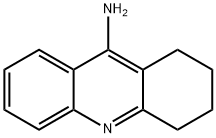1,2,3,4-TETRAHYDRO-9-ACRIDINAMINE

|
- ₹0
- Product name: 1,2,3,4-TETRAHYDRO-9-ACRIDINAMINE
- CAS: 321-64-2
- MF: C13H14N2
- MW: 198.26
- EINECS:206-291-2
- MDL Number:MFCD00046923
- Synonyms:1,2,3,4-tetrahydro-9-acridinamin ;1,2,3,4-tetrahydro-9-amino-acridin ;1,2,3,4-Tetrahydro-9-aminoacridine;5-Amino-6,7,8,9-tetrahydroacridine;Acridine, 1,2,3,4-tetrahydro-9-amino-;Acridine, 9-amino-1,2,3,4-tetrahydro-;Acridine, 9-aminotetrahydro-;CS 12602
| Manufacturer | Product number | Product description | Packaging | Price | Updated | Buy |
|---|
Properties
Melting point :183.5℃
Boiling point :325.59°C (rough estimate)
Density :0.9827 (rough estimate)
refractive index :1.4400 (estimate)
storage temp. :4°C, away from moisture and light
solubility :DMSO (Slightly), Methanol (Slightly)
form :Solid
pka :9?+-.0.20(Predicted)
color :White to Pale Yellow
CAS DataBase Reference :321-64-2(CAS DataBase Reference)
Boiling point :325.59°C (rough estimate)
Density :0.9827 (rough estimate)
refractive index :1.4400 (estimate)
storage temp. :4°C, away from moisture and light
solubility :DMSO (Slightly), Methanol (Slightly)
form :Solid
pka :9?+-.0.20(Predicted)
color :White to Pale Yellow
CAS DataBase Reference :321-64-2(CAS DataBase Reference)
Safety Information
| Symbol(GHS): |

|
||||||||||||||||||||||||
|---|---|---|---|---|---|---|---|---|---|---|---|---|---|---|---|---|---|---|---|---|---|---|---|---|---|
| Signal word: | Danger | ||||||||||||||||||||||||
| Hazard statements: |
|
||||||||||||||||||||||||
| Precautionary statements: |
|
Description
In the 1950s, tacrine was used experimentally to reverse cholinergic coma in animals. In the 1960s, tacrine was used to reverse the effects of phencyclidine-like drugs. It was also marketed for many years as a respiratory stimulant. In 1993, the US Food and Drug Administration approved tacrine for the treatment of symptoms of mild to moderate Alzheimer’s disease.More related product prices
206658-92-6 1,2,3,4-TETRAHYDRO-9-ACRIDINAMINE TACRINE HYDROCHLORIDE Acridine 9-AMINOACRIDINERelated product price
- 206658-92-6
₹4189.28-14800 - Acridine
₹3063.6-44100.3 - 9-AMINOACRIDINE
₹4500-15700






